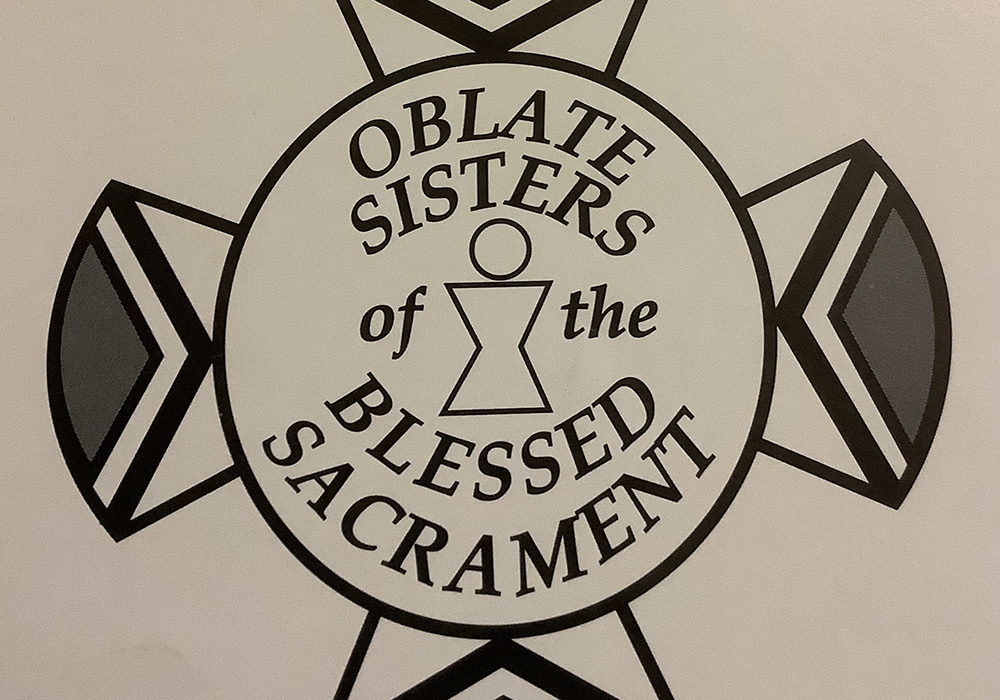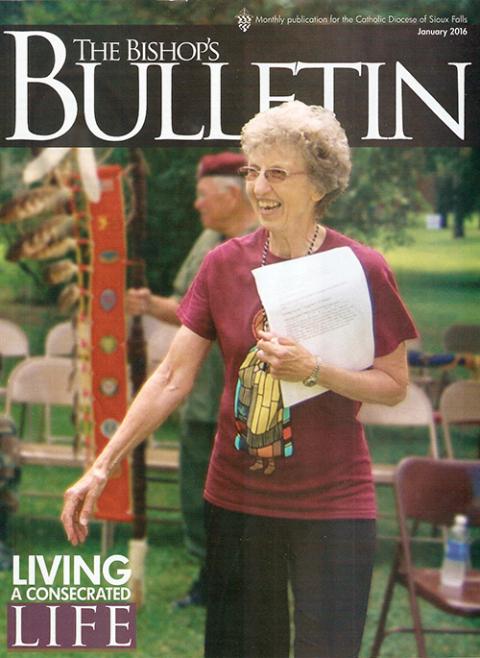
The logo of the Oblate Sisters of the Blessed Sacrament, initially formed in the 1930s for Native American women who wanted to join religious life (Courtesy of the Oblate Sisters of the Blessed Sacrament)
Sr. Pat Mylott first fell in love with Native American culture when she learned about Crazy Horse in eighth grade. She even tried to learn a Native language, but living in Youngstown, Ohio, she had no opportunity to hear the correct pronunciation of the words she memorized.
But five years later, in 1960, she joined the Oblate Sisters of the Blessed Sacrament and began ministry in Marty, South Dakota, where she taught history at what was then known as St. Paul's Indian Mission School on the Yankton Sioux Reservation. In the 1970s, the school was transferred to the tribe to run and is now known as Marty Indian School.
"I didn't come out here blind, but I'd never met an Indian person," Mylott said. "But I really enjoy working here."
According to St. Paul’s Indian Mission, The Oblate Sisters of the Blessed Sacrament were founded at Marty in 1935 through the work of a Benedictine priest and St. Katherine Drexel, whose Sisters of the Blessed Sacrament ministered there. Young Native women in the mission school wanted to join Drexel's order, but could not because it was segregated. The little congregation was initially open only to Native women, but soon began to admit anyone.
"We were never a large community," said Sr. Miriam Shindelar, the order's superior. "I don't think we ever had more than 18 professed sisters."
Now there are only three: Mylott, age 82; Shindelar, age 80; and Sr. Joan Vittengl, 89. The last Native American sister in the community, Inez Jetty, died two years ago.
None of the three have really retired, despite their age. Mylott stays busy fighting human trafficking and taking Communion to the homebound. The sisters' biggest job is helping with funeral wakes — in the Yankton Sioux culture, wakes last for two, three or even four days after someone dies, and the sisters are there to lend a helping hand.
Marty has a population of less than 700, and is unincorporated. Nearly everyone is Native American, and three out of four people live in poverty, according to the U.S. Census Bureau. Only 53% of residents have a high school diploma, and zero percent, the Census says, have a bachelor's degree.
This makes girls and young women on the reservation especially susceptible to trafficking, Mylott said.
"Our main thing is we've been putting up big signs to warn people: Traffickers are after your children," she said.
Even in Marty, on the wind-swept plains two hours west of Sioux Falls, the past is inescapable. The old St. Paul's school has long been replaced by a new complex across the street, but the old buildings still stand. For many, they are a painful reminder of abuse that took place there.
Advertisement
More than 100 former students filed lawsuits between 2003 and 2010 against the Oblate Sisters of the Blessed Sacrament, the Sisters of the Blessed Sacrament, the Benedictine order and the Sioux Falls Diocese, alleging they were sexually abused by priests and nuns, all deceased, at the boarding school. All of the lawsuits were dismissed in 2012 after the state adopted a law preventing abuse lawsuits by anyone age 40 or older.
The school was just one of more than 400 government-funded boarding schools across the country from 1819 to the 1970s; many of those were run by religious groups, including Catholic dioceses and religious orders. In May 2022, the U.S. Department of the Interior released its initial report on the schools, showing they were rife with corporal punishment, including solitary confinement, withholding of food, and whipping and other physical abuse. There are also reports of sexual abuse and the trauma of children being forcibly taken from their homes, having their hair cut, and being prohibited from speaking their native languages.
More than 500 children died at 19 of the schools, according to the government report, and burial sites have been found at 53 schools — numbers that are expected to rise. It is unknown when the next government report may be released.
The Catholic Truth & Healing website lists 87 Catholic-run Native boarding schools before 1978 across 22 states. Seventy-four of those schools were run or staffed by Catholic women religious. Fifty-three different congregations of sisters were affiliated with the schools.

Sr. Miriam Shindelar, superior of the Oblate Sisters of the Blessed Sacrament, is shown on the cover of the Sioux Falls, South Dakota, diocesan magazine in 2016. (Courtesy of the Oblate Sisters of the Blessed Sacrament)
Shindelar said the entire situation is painful: The pain of a decade of legal wrangling, the pain of those who have animosity toward the Catholic Church and the sisters because of what happened, and, most of all, the pain she sees in the community she loves so much — the pain of generation after generation of trauma caused by the boarding school system, which was created to destroy Native culture. Repeated generations did not learn parenting because of the schools, and domestic abuse and drug and alcohol abuse are rampant.
"We're all still in the healing process," Shindelar said. "We're dearly loved, but it hurts me because I see the trauma and what's happened since. It continues and continues — but you do see pockets of change and that gives you hope."
She said the sisters were unwittingly part of a horrific situation.
"We have a much greater understanding today," Shindelar said. "The first year I was here, I was in the dorm and had 91 high school girls to look after. I was in charge of a kitchen serving 500 people. I didn't have the time, really, to look out at the community and realize the depth of what was going on."
Mylott said most people see the dedication of the sisters and love them, separating them from what others did in the past.
"Are we loved? It seems like people are expressing that more than ever," Mylott said. "I wish we could do more — to paint everybody with the same brush is wrong."
Her biggest worry is that the three sisters that are left won't be here forever, and the community is going to have to take care of itself.
"For years we've been trying to train people to take leadership, but they still count on us," she said. "What's going to happen when we can't do that? They'll have to figure it out."
Shindelar said that over the years she volunteered for other missions but was always denied and told she was needed in Marty. Now she knows the wide-open spaces of southern South Dakota are where she belongs.
"I have a great love for God and my calling. And I realize he called me to a place," she said. "And I love the people."







